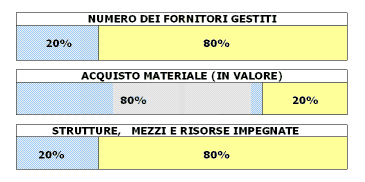
Chapter 2: The supplying process
2.1 Introduction
The modernization of the administrative structure has endured in the years a smaller increment
regarding the developments of the production processes.
Both consume resources for the generation of respect to you output,
however while a productive surplus generates for the enterprise value, in administrative field the consumption of a surplus of
resources generates one reduction of the value.
Such loss of value can to be avoided through one rationalization of the
processes trained to you.
Today we have means in order to organize in efficient way the activity administrative and to
reduce expenses, like the computer science automation and the outsourcing of the processes, in particular of supplyings,
that they represent the prevailing part of the administrative structure.
Based on the situation delineated in the previous
understood one it it is possible to notice as the modality of the supplying process back is evolvendo new organizational
shapes whose solutions differ to second of the purpose that it is wanted to be pursued through the supplying process.
The crescent complexity and variety of the production needs more and more of an elaborated system of supplying that it
comprises is the strategic phase of the purchases is considers the optimization of the processes.
In the prosieguo
of the understood one it it will in the first place be proceeded to define a distinction between what concerns the purchase
and what s' means for supplying, of continuation it will come described who are the actors who take part to the supplying
process and the activities who compose it.
Outline of regarding reading will come shown one the composite world of the
E-procurement taking in consideration:
2.2. Definition of the concepts of "Purchase" and "Supplying"
Presupposing in order to better comprise the just positioning of the process of approvigionamento
in the entire business within is the distinction between that it concerns "To acquire" and "To provision".
In a generalized manner for "purchase" we mean with of activity, whose importance is strategic for the entire enterprise.
The participation areas are:

2.3. The Actors of the Process of Supplying
A first necessary step for the analysis of the process of traditional supplying is to evidence
the actors who of it take part.
From the side of the offer there are the suppliers who put to disposition
the necessary material for run regulating of transactions of the enterprise whose production schedule can be
influenced strongly from the quality of the products and the performances of the supplier.
From the side of the question
there is the enterprise . The structure of an enterprise can to be much various one from others for which
here fará reference like example to the structure of a Unitec customer, " society
s.r.l. ", in order to evidence
the actors of the process who, in a generalized manner are present in all the enterprises.
The actors who take part to the supplying process are: the production unit, the unit acquires, the warehouse, contabilitá
and the administration.
As it is evidenced in fig.1 the all these functions are intercorrelate from a series of activity
that they will be described in the successive paragraph.

| Top | Summary | < < Previous | Next > > /en/home.php" TARGET="_blank">>> Home Page << |